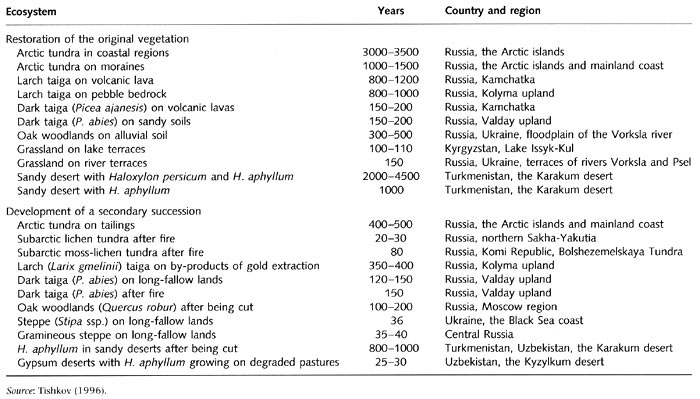Please put an active hyperlink to our site (www.rusnature.info) when you copy the materials from this page
Environmental problems of Northern Eurasia
Nature Protection and Conservation
<<< Geography of Biodiversity and
Human Impact | Environmental Problems Index | State of Biodiversity and Conservation >>>
Restoration of Primary Vegetation in Damaged Ecosystems
The potential of impacted ecosystems for restoration can be evaluated through the
analysis of data on regrowth of primary vegetation and duration of restoration periods
required by different ecosystems subjected to anthropogenic disruption. The data presented
in Table 24.4 show that after certain impacts and under favourable conditions, many
ecosystems are capable of relatively rapid restoration. However, if large areas have been
impacted, restoration may proceed at a slower rate and with limited success. The
monopolization of habitats by superior competitors (often introduced species) is one
factor that can affect regrowth. Another problem is that the general depletion of biota
can lead to the extinction of rare species. Unfortunately, in Northern Eurasia the share
of rare species is the highest in the traditional agricultural regions which are heavily
impacted. In the Caucasus, Transcaucasia, and Central Asia, rare species account for 12-25
per cent of all species, and in the steppes of the Ukraine and Southern Russia, in the
Transbaikal region and the Far East rare plant species account for 7-12 per cent. They are
less important in agricultural areas of central European Russia, which have no more than
5-7 per cent of rare species in their floras, while in the taiga rare plant species
constitute less than 2-5 per cent (Environmental and Health Atlas of Russia, 1995).

Table 24.4 Time required for the restoration of the original vegetation
and development of a secondary succession in some zonal ecosystems of Northern Eurasia
Degradation of ecosystems and the high rates of replacement of primary vegetation by
secondary successions is a matter of serious concern. Out of a total of 2.8 million km2
of reindeer pastures, 700 000 km2 are degraded. In the last twenty-five years,
the areas in the tundra occupied by lichens (major reindeer forage) have decreased by a
factor of 2. Sedges frequently replace the typical moss-shrub communities (Yablokov et
al., 1996). A number of negative processes affects the taiga vegetation. Between 1988 and
1997, areas of annual timber cutting in taiga have been reduced by a factor of 2
(Amirkhanov, 1997). However, in the course of intensive rejuvenation, the structure of
forests changes. Typical coniferous species (Picea abies, Picea obovata, Pinus sibirica,
P. sylvestris) are replaced by a small-leaved deciduous species such as Betula, Populus
tremula, and Alnus incana. Under threat of extinction are xerophilous forests of the
Northern Caucasus and the Black Sea coast. Only fragments of the Mediterranean-type
xerophilous forests remain in the coastal mountains in the west of the Krasnodar region.
These ecosystems are insufficiently represented in protected areas.
There has been some success in conservation of forests. Protection of forests in Russia
is regulated by the Forest Code of the Russian Federation (1997). According to the Code,
there are three categories of forests: (1) those where cutting is prohibited (e.g.,
riparian forests, forests in zapovedniks and national parks, greenbelts, forests on the
southern and northern margins of biomes); (2) forests whose use is restricted, (e.g., in
mountainous regions and poorly forested locations); (3) forest for industrial harvesting.
Because of the territorial increase of protected areas, in the past few years the share of
forests belonging to the first and second categories has increased. Every year,
reforestation is carried out on 3000-3500 km2; another 8000-10000 km2
are areas of assisted natural forest restoration.
<<< Geography of Biodiversity and
Human Impact | Environmental Problems Index | State of Biodiversity and Conservation >>>
Contents of the Nature Protection and
Conservation section:
Other sections of Environmental Problems of Nortern Eurasia:
|
|